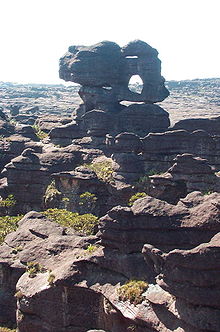Tepui

A tepui (or tepuy) (Template:PronEng) is a table-top mountain (mesa) found in the Guiana Highlands of South America, especially in Venezuela. The word tepui means "house of the gods" in the native tongue of the Pemon, the indigenous people who inhabit the Gran Sabana. Tepuis tend to be found as isolated entities rather than in connected ranges, which makes them the host of a unique array of endemic plant and animal species. Some of the most outstanding tepuis are Autana, Auyantepui and Mount Roraima (the highest and most famous one, on the border tripoint of Venezuela, Brazil and Guyana). They are typically composed of sheer blocks of Precambrian quartz arenite sandstone that rise abruptly from the jungle, giving rise to spectacular natural scenery. Auyantepui is the source of Angel Falls, the world's tallest waterfall.
Morphology

These table-top mountains are the remains of a large, sandstone plateau that once covered the granite basement complex between the north border of the Amazon Basin and the Orinoco, between the Atlantic coast and the Rio Negro. Throughout the course of the history of Earth, the plateau was eroded, and the tepuis were formed from the remaining monadnocks.

There are 115 such mesas in the Gran Sabana in the south-east of Venezuela on the border with Guyana and Brazil, where the highest concentration of tepuis is found. The precipitous mountains tower over the surrounding area by up to 1,000 meters. On top of the mountains grow various types of forests with a wide variety of orchids and bromeliads species.
Because of their great age, some tepuis exhibit surface features and subsurface caves that are typical of more water-soluble rock such as limestone. Caves here include the 671m deep Abismo Guy Collet, the deepest quartzite cave in the world. Some of the mesas are pocked with giant sinkholes up to 300 metres in diameter and with sheer walls up to 300 metres deep. These sinkholes are formed when the roofs of tunnels carved by underground rivers collapse.
Flora and fauna

The plateau of the tepuis is completely isolated from the ground forest, making them ecological islands. The altitude causes them to have a different climate from the ground forest. The top presents cool temperatures with frequent rainfall, while the bases of the mountains have a tropical, warm and humid climate. The isolation has led to the presence of endemic flora and fauna through evolution over millennia of a different world of animal and plants, cut off from the rest of the world by the imposing rock walls. Some tepui sinkholes contain species that have evolved in these "islands within islands" that are unique to that sinkhole. The tepuis are often referred to as the Galápagos Islands of the mainland, having a large number of unique plants and animals not found anywhere else in the world. The floors of the mesas are poor in nutrients, which has led to a rich variety of carnivorous plants. The weathered, craggy nature of the rocky ground means no layers of humus are formed.
The tepuis, also known as 'islands above the rainforest', are a challenge for researchers, as they are home to a high number of new species which have yet to be described.[1] A few of these mountains are cloaked by thick clouds almost the whole year round. Their surfaces could previously only be photographed by helicopter radar equipment. Humans have still yet to set foot on many of the tepuis.[citation needed]
Most tepuis are in the Canaima National Park in Venezuela, which has been classified as a World Heritage Site by UNESCO.
Selected tepuis


A few of the most notable of the 115[citation needed] Tepuis:
- Auyantepui is the largest of the tepuis with a surface area of 700 km². Angel Falls, the highest waterfall in the world, drops from a cleft in the summit.
- Mount Roraima, also known as Roraima Tepui. A report by the noted South American researcher Robert Schomburgk inspired the Scottish author Arthur Conan Doyle to write his novel The Lost World about the discovery of a living prehistoric world full of dinosaurs and primeval plants. The borders of Venezuela, Brazil, and Guyana meet on the top.
- Matawi Tepui, also known as Kukenán, because it is the source of the Kukenán River, is considered the "place of the dead" by the local Pemon Indians. Located next to Mount Roraima in Venezuela.[citation needed]
- Autana Tepui stands 1,300 m above the forest floor. A unique cave runs from one side of the mountain to the other.
- Ptari Tepui's sheer rock walls are so isolated, it is believed[who?] a high number of endemic plant and animal species could be found there.
- Sarisariñama Tepui, famous for its almost perfectly circular sinkholes which go straight down from the mountain top - the largest such sinkhole is 350 meters in diameter and depth (purportedly created by groundwater erosion). They harbor an ecosystem composed of unique plant and animal species at the bottom.
See also
References
- Much of the text of this article comes from the corresponding German-language Wikipedia article, retrieved on 16 February 2006, which uses the following sources:
- Uwe George: Inseln in der Zeit. GEO - Gruner + Jahr AG & Co., Hamburg, ISBN 3-570-06212-0.
- Roland Stuckardt: Sitze der Götter. terra - Heft 3/2004, Tecklenborg Verlag, Steinfurt.
National Geographic, May 1989, "Venezuela's Islands in Time," pgs 526-561
External links
- http://www.worldwildlife.org/wildworld/profiles/terrestrial/nt/nt0169_full.html
- The Making of the Tepuis Film : "The Living Edens : The Lost World"
- Mongabay.com -- pictures from Tepuis in Venezuela.
